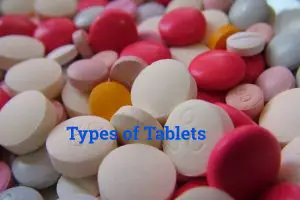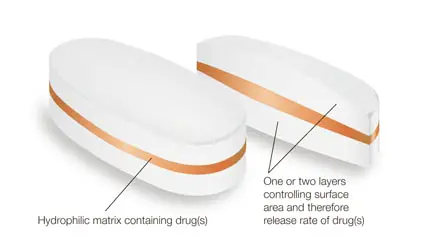Doctors and physicians prescribe tablets for most disease conditions.
There are different types of tablets, but all look similar except in terms of shape, size, and color.
But in fact, tablets are designed after careful thought by pharmacists.
They are designed to meet the patient’s requirements, disease state, medicine content, and other factors.
Hence we can hear names like sustain release tablets, quick soluble tablets, film-coated tablets, etc.
But few things are common to all of them.
- When a tablet is swallowed, it gets broken down or starts to dissolve in the body fluids.
- After dissolution, the medicament inside is released into body fluid in the gut.
- From there, it enters the blood and circulates to the whole of the body.
Each tablet includes the drug ingredients and other substances to enhance the size, mask the bitter taste or enhance the appeal.
Tablets pass through the oral route, which is the easiest Route of Medication Administration.
Different Types of tablets
In a broad sense, tablets are classified as
- Compressed tablets &
- Molded tablets.
These two tablet types are further classified base on purpose, use, and mode of administration as
Compressed tablets
- Oral tablets
- Chewable tablets
- Buccal or sublingual tablets
- Lozenges
- Effervescent tablets
- Enteric-coated tablets
- Sustained-release tablets
- Vaginal tablets
- Sugar-coated tablets
- Film-coated tablets
- Layered tablets
- Implants
- Soluble tablets.
- Pressed coated tablets.
Molded tablets
These are of two types as
- Hypodermic tablets
- Dispensing tablets
The compressed tablets are made on a large scale, while molded tablets are made on a short scale for experimentation or for occasional use.
Based on surface Coating of tablets
a) Film-coated tablets

- These tablets have a filmy, shiny, and very smooth coating on their surface.
- In general, the coating is done to enable the dissolution of tablets in the intestine rather than in the stomach.
- This is done to enhance solubility in basic pH or to avoid damage in the stomach for better availability to the body.
b) Simple or Un-coated tablets

- These are routine tablets and do not have special coatings.
- These tablets are less expensive than other forms of tablets.
- They contain the drug as the main ingredient and other additives to enhance the bulk of tablets and give the desired color.
Based on the drug release profile:
a) Fast release tablets
- These tablets are designed to release the drug ingredients faster than normal.
b) Regular release tablets
- These are routine tablets that start releasing the drug once they reach the stomach.
c) Delayed-release tablets.
- These tablets are designed to release the drug over a period of 24 hours.
- The intention is to give a single dose administration for the whole day relief of symptoms.
- They have a high concentration of drugs than normal tablets. Also, they are quite expensive than other tablets.
Based on the route of administration
a) Oral tablets:
- These are the tablets that are taken by swallowing along with a glass of water.
- They are the most common types of tablets.
b) Sub-lingual tablets.
- As the name indicates, these tablets are put below the tongue and are designed to release drugs.
- These tablets are meant for fast action in some disease conditions like a heart attack.
- For example, glyceryl trinitrate is given as a tablet in case of a heart attack that is put below the tongue.
- It dissolves faster to release the drug and save the patient from death.
c) Chewable tablets
- These are big-sized tablets that are difficult to swallow.
- Hence they are made such that they are consumed by biting and chewing the tablet. Most of the antacid tablets are chewable types.
d) Effervescent tablets etc
- These are tablets that are meant to be dissolved in water and then consumed.
- These tablets when placed in water, immediately break down to release the drug.
- So we have different kinds of tablets but all of them are very easy to administer with the correct dose.
- Hence they are widely used. Let us see the details of the above-mentioned tablets.
e) Layered tablets
- These tablets are layered or have two or more layers of ingredients.
Unlike conventional tablets, where we have a single piece of substance molded to shape, here two or more layers of material are aligned into a tablet for control release of the formulation.

- As we can see in the above image, there are three layers in the tablet.
- Two white layers and a center reddish-brown layer.
- The layer at the middle has medicament while the other two are just to control the tablet dissolution rate and medicament release.
f) Implants

- These are the tablets meant to be put in the body sub-surfaces mostly below the skin or into muscles.
- These implants one inserted into the body tissues, they release the drug slowly over a period of months to a year.
- Drugs like contraceptives, steroids are given in this route.
- There is no need for regular administration of the drug if these implants are used.
But they can cause pain and sometimes release excess drugs leading to toxicity.
I am not really sure that implants belong to tablets, it should be rather defined as medical device. I agree with comment above about the source.
Thank you
this material need references
Thank you
thank you